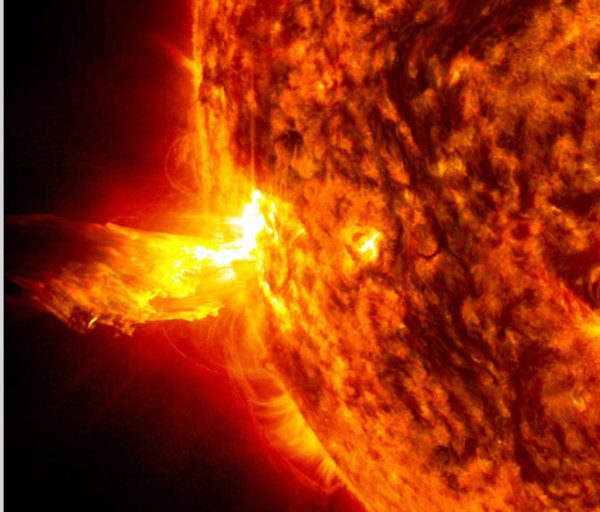Swarm of NASA nanosats to probe source of solar eruptions – Astronomy Now Online

NASA has selected a mission to dispatch six CubeSats, each the size of a toaster oven, to an orbit more than 32,000 kilometres (20,000 miles) from Earth to study massive particle ejections from the Sun.
The Sun Radio Interferometer Space Experiment, or SunRISE, mission will launch no later than 1 July 2023, after its selection by NASA as a mission of opportunity under the agency’s Explorers programme.
SunRISE will consist of six CubeSats flying as close as 10 kilometres (6 miles) from each other. The nanosatellites will together act as a giant radio telescope, detecting low-frequency emissions from solar activity and downlinking the measurements through NASA’s Deep Space Network.
Data gathered by the SunRISE CubeSats will tell scientists about the source of coronal mass ejections, which launch huge bubbles of gas and magnetic fields from the sun. Employing a constellation of small satellites will allow researchers to localise the eruptions.
Coronal mass ejections accelerate energetic particles throughout the Solar System, and the particles can spawn geomagnetic storms when they reach Earth. Such storms can impact radio communications, satellite navigation, electrical grids and satellite and human spaceflight operations.
“We are so pleased to add a new mission to our fleet of spacecraft that help us better understand the sun, as well as how our star influences the space environment between planets,” said Nicky Fox, director of NASA’s heliophysics division. “The more we know about how the Sun erupts with space weather events, the more we can mitigate their effects on spacecraft and astronauts.”
Scientists want to better understand the processes at the sun that accelerate solar energetic particles during coronal mass ejections.
The six SunRISE CubeSats will detect radio emissions simultaneously from slightly different locations in space. The radio signals that are the focus of the SunRISE mission are blocked by Earth’s atmosphere, so scientists must send up satellites to study them.
The SunRISE mission will create 3D maps to pinpoint the locations of powerful solar eruptions, while tracking how the particle clouds and magnetic field lines evolve as they depart the sun. According to NASA, the data will help determine what initiates and accelerates the giant jets of radiation.
The principal investigator for the SunRISE mission is Justin Kasper at the University of Michigan in Ann Arbor. The mission will be managed at NASA’s Jet Propulsion Laboratory in Pasadena, California.
NASA says the SunRISE mission will cost $62.6 million to design, build and launch.
Each of the SunRISE nanosatellites is a six-unit, or 6U, CubeSat. They will launch together on a geostationary satellite built by Maxar Technologies equipped with a Payload Orbital Delivery System, or PODS, rideshare accommodation.
The Maxar-built satellite will deploy the SunRISE satellites into an orbit just above geostationary altitude — a so-called GEO graveyard orbit — more than 22,000 miles above Earth, Kasper said in an email to Spaceflight Now.
Kasper said Maxar and NASA have not identified the satellite that SunRISE will ride into orbit. That will come in about one year, he said.
The SunRISE satellites will be built at the Space Dynamics Laboratory at Utah State University, and the radio detectors will be provided by JPL, according to Kasper.
SunRISE was selected in 2017 for an 11-month mission concept study as one of two missions of opportunity under NASA’s Explorers programme. In February 2019, NASA approved an extended formulation study for an additional year to further mature technologies and plans for the SunRISE mission.
The other mission of opportunity selected for study in 2017 was the Atmospheric Waves Experiment, or AWE, mission. NASA decided last year to proceed with development of the $42 million AWE mission, which will mount an instrument outside the International Space Station to investigate the link between weather patterns in Earth’s atmosphere and space weather.
Email the author.
Follow Stephen Clark on Twitter: @StephenClark1.





